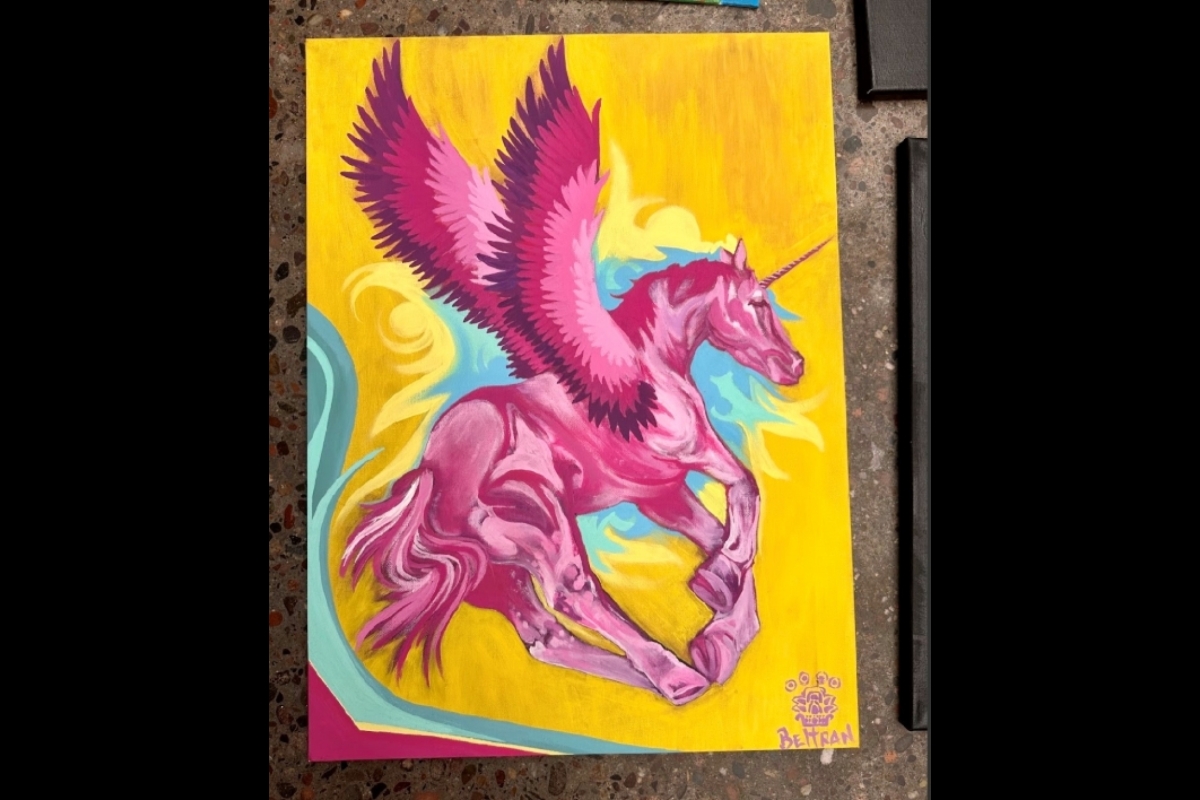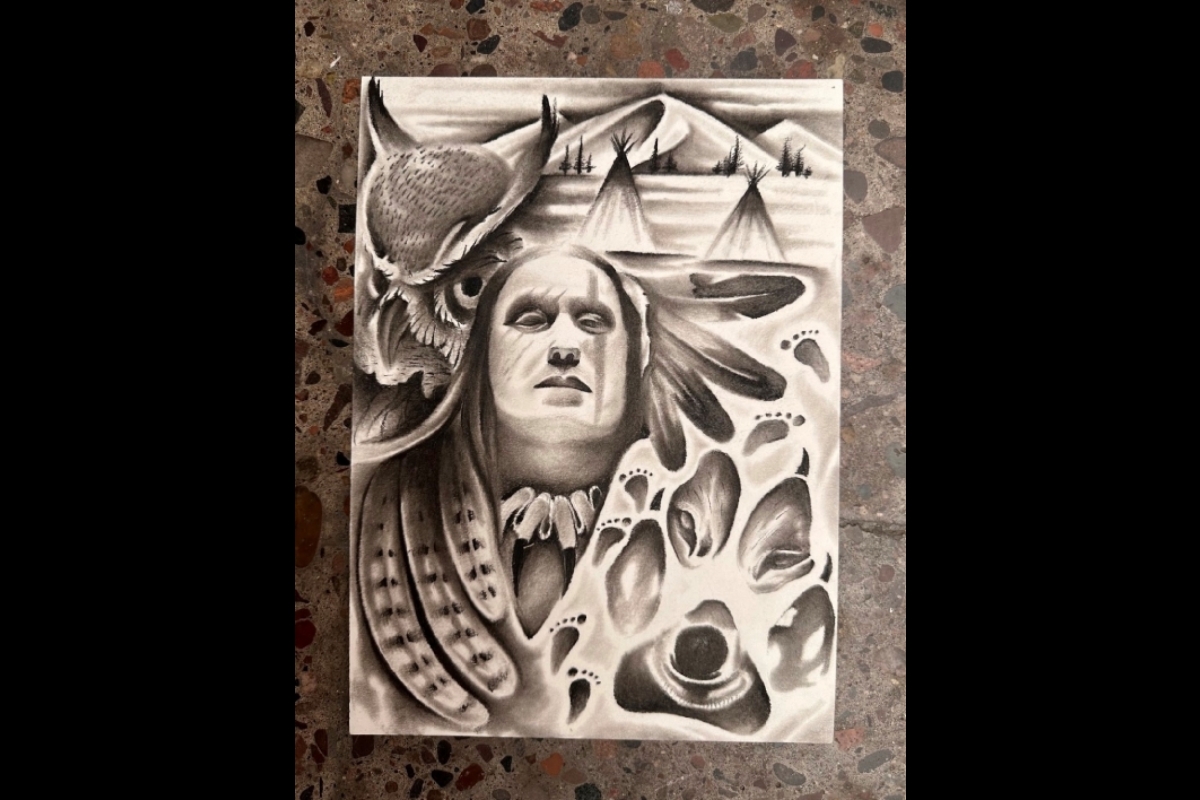ASU show of artworks by incarcerated people to fund scholarship

When Bruce Ward went to Walmart to buy art supplies in August 2020, he was nearly blinded by the array of paint colors.
Days earlier, he had ended 11 years and 40 days of incarceration.
Days later, he would become a full-time student in the School of Art at Arizona State University, continuing a passion that was sparked during his time at Florence Correctional Center.
In 2017, the Center for Correctional Solutions at Arizona State University held its first {Ink}carcerated show, featuring artworks created by men and women who were incarcerated in Arizona. Ward worked hard to finish an elaborate portrait in acrylics so he could donate it to the show.
Six years later, Ward is two semesters away from graduation and is co-curating the fourth {Ink}carcerated show, set for 5 to 10 p.m. Friday, May 12, at Gallery 100 in Tempe. The event is a partnership between the Center for Correctional Solutions at ASU and the Arizona Department of Corrections Rehabilitation and Reentry program.
This year’s {Ink}carcerated show will display nearly 500 artworks from 11 units at seven correctional locations around the state. Buyers pay whatever amount they wish to donate per artwork.
In previous years, proceeds from the show have benefited various arts charities. This year, the money raised will go toward the new ASU Center for Correctional Solutions Scholarship, to fund higher education for currently or formerly incarcerated individuals or their families, or current or former correctional staff or their families.
“We’ve always tried to focus on a beneficiary that could potentially disrupt the cycle of incarceration and we wanted it to be meaningful to the artists in some way,” said Kevin Wright, director of the center and associate professor in the School of Criminology and Criminal Justice at ASU.
The show has been supported by the Department of Corrections, which produced a video of some of the artists at work that will be screened at the show.
“We’ve had multiple prisoners and multiple staff members reach out to us and say, ‘Can my unit be involved?’" Wright said.
“I was thinking back to 2017 when we had 75 pieces, and now we have some artists with multiple pieces, so, much like a real gallery, we’ll have collections from one artist hanging together.”
For 2023, “we wanted to bring it closer to the artists and the people producing the work in that, that if not directly, then indirectly benefit them or their families or the correctional staff,” Wright said.
The other student curator is Alexis Klemm, who graduated from ASU this week with a master’s degree in criminology and criminal justice. She’ll start the PhD program in criminology and criminal justice at ASU in the fall and, after working with the Center for Correctional Solutions and participating in the Inside-Out Prison Exchange for the past few years, decided she wants to stay connected to work in the correctional system.
“I constantly get asked if I’m scared when I go into a prison. It’s the first thing everyone asks me and I would say the answer to that is no,” she said.
“Everyone I’ve worked with directly on the inside is excited to do things like this. Everyone I’ve had the privilege of working alongside who is incarcerated has a similar mindset to us and the work we do.”
Klemm collected impact statements from people involved with the show. A group of female artists who are incarcerated wrote: “Giving us space to express our thoughts and emotions through our creativity means a great deal to us.”
A staff member at a correctional facility wrote: “This was the moment I saw women who had been told to sit down and be quiet their whole incarceration finally speak up. And I heard them.”
Ward, who is majoring in sculpture, said that creating art while he was incarcerated was a turning point for him.
“Looking back, it was what told me that I was an artist and a community member and I could donate my work to charity,” he said.
Later, he participated in an Inside-Out Prison Exchange class taught by Wright.
“I started to piece together in that class that I could get out and go to college instead of becoming an artist in a garage and doing it the hardest way possible,” said Ward, who earned two associate degrees from Rio Salado College while he was incarcerated.
In the first few months after leaving the Florence Correctional Center in 2020, Ward was overwhelmed by culture shock.
“It’s sensory – like traveling in a vehicle and all the bright colors and people moving in every direction,” he said.
“I was getting out during COVID, and I’m thankful that society was shut down so I had some months to calibrate.”
In his time pursuing a degree in sculpting at ASU, he’s been trying to say “yes” to everything.
“I’m trying to open myself up and not be introverted, which is easy after confinement,” he said. “I’m trying to say yes to opportunities to keep me in the loop.”
Ward has mentored artists who are incarcerated and also, like him, veterans.
“One of the things I tell them is that the time for you to form an identity is not the day you hit the gates,” he said.
“Before you get out, you need to identify as a member of the community, and this show gives them that.”
Top image: Visitors enjoy the artworks during the 2022 {Ink}carcerated show. Photo by Lisa Rolland-Keith/Watts College of Public Service and Community Solutions




